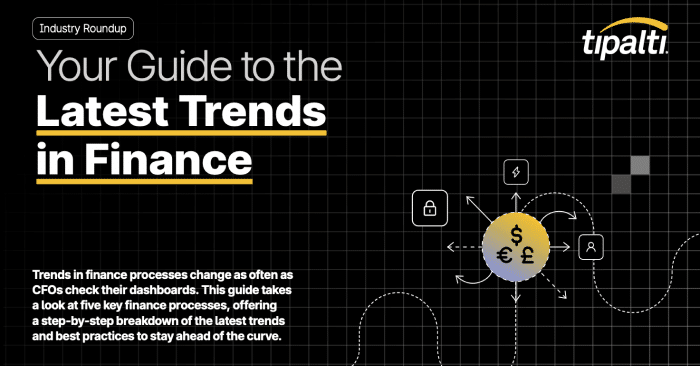
Finance trends shift fast—explore 5 key processes & tips to stay ahead.
Fill out the form to get your free eBook.

Trends in finance processes change as often as CFOs check their dashboards. This guide takes a look at five key finance processes, offering a step-by-step breakdown of the latest trends and best practices to stay ahead of the curve.
When I started in finance, our Financial Planning and Analysis team (FP&A) was known for one thing: the plan. We’d take the company’s budget, track actuals, flag deviations, and keep everyone accountable. It was a vital function—keeping the financial train moving—but it wasn’t exactly viewed as a strategic engine.
Fast forward to today, and the landscape looks entirely different. In a market where uncertainty is the norm (foreign exchange fluctuations, shifting customer behavior, interest rate volatility), FP&A teams are expected to look forward, not back. The question is no longer “Are we on plan?” but “Are we making the right decisions for what’s ahead?”
From Reporters to Advisors
In the past, the FP&A function operated like a reporting engine—collecting data and producing monthly summaries. Now, we’re being asked to serve as interpreters of the business. That means understanding not only the numbers but also the operational context behind them.
In my team’s case, that means sitting alongside all business departments, such as marketing and sales, to understand how campaigns perform or how pricing decisions are implemented in real-time. We’re not there to police spending—we’re there to help inform decision-making.
It’s a different kind of partnership. When a department lead asks, “Can we afford this?” the answer isn’t just a yes or no. It’s “Here’s what it means for margin, for growth, and for our next funding cycle.” That’s where we become part of the strategy. It’s this mindset change—from financial reporter to strategic partner—that’s redefining the value of FP&A.
Cutting Through KPI Overload
One of the biggest challenges with this strategic shift is focusing on the right data. Every company today has a thousand dashboards and more KPIs than anyone can realistically act on. The temptation to measure everything can override what really matters.
My advice is to narrow it down to around five metrics that truly define success, like topline growth, profitability, customer acquisition cost, activation rate, and Net Promoter Score. Metrics like these give us a pulse on whether we’re growing the right way—efficiently, sustainably, and with customer satisfaction intact.
For FP&A, the need to prioritize is critical. It’s not that the other metrics don’t matter, but our role is to distill the numbers into actionable insight. If leadership can look at a single slide and immediately understand the company’s health, we’ve done our job.
Planning for Uncertainty
In addition to designating the right KPIs, the FP&A function needs to account for unpredictable factors that impact our plans. Scenario planning has become the backbone of this process. Instead of treating the forecast as a single truth, we model a range of outcomes (baseline, upside, downside) and test our assumptions.
Interest rates, currency shifts, and customer retention are all variables we can’t control. But we can model their impact. What matters isn’t getting every prediction right—it’s understanding what each scenario would mean for the business, and what we can do in response.
It’s a form of risk management that gives leadership confidence that we’re not caught off guard when conditions change, as they inevitably will.
Automation: The Unsung Hero
When I first built out my FP&A team, the process of tracking the right KPIs and forecasting different scenarios was painfully manual. Pulling data from our ERP and CRM systems, cleaning it, checking for errors, and loading it into spreadsheets consumed days. It wasn’t sustainable, and it certainly wasn’t strategic.
Automation changed everything. Once we connected our data sources and built automated reporting pipelines, we freed up entire workweeks that used to be spent on data prep. Suddenly, we had time to focus on why metrics moved, not just how much.
The Promise (and Pragmatism) of AI
When assessing the ROI of automation and technology, AI represents the next frontier of opportunity. Many FP&A teams, including ours, are still in the exploratory phase. We’ve taken specialized AI finance training and started experimenting with use cases like anomaly detection, data validation, and automated report summaries.
One area I’m especially excited about is AI-generated executive summaries. Uploading a CSV of performance data and having AI draft a clear, readable summary isn’t just a time saver—it’s a communication breakthrough. For finance professionals who are more comfortable with numbers than storytelling, AI can help bridge that gap.
But like any new technology, success depends on intention. We’ve set a rule within our team: 10–15% of our time should be dedicated to AI experimentation. If innovation isn’t built into our schedules, it doesn’t happen.
But the goal with any new tech isn’t to replace human insight, it’s to amplify it. AI can handle heavy data work, but interpreting the “why” still requires our human judgment and business context.
The FP&A Team as True Business Partners
Beyond technology innovation, there’s one shift I’ve seen that’s made the biggest difference. It’s bringing FP&A into the conversation earlier. Too often, finance is called in after the fact to approve budgets or adjust forecasts.
But when FP&A drives weekly or monthly department meetings, it changes everything. We see the decisions forming in real time and can offer a perspective that helps guide them.
I often tell my team: “You’re the CFO for your business unit, but you’re also the COO.” Numbers alone don’t drive growth. It’s how well we interpret them in the context of people, processes, and strategy that makes the difference.
The Future of FP&A
Today, the FP&A function is shifting from a support role to a true strategic business partner. The combination of technology, better data, and a more collaborative approach has reshaped what’s expected from our teams. While we’re still analysts, we’re also translators and connectors—bridging the gap between operations and strategy, between what’s planned and what’s possible.
As an FP&A team, our new mandate is clear: embrace automation, experiment with AI, and build cross-functional partnerships. That’s where we’ll add the most value—not by perfecting the spreadsheet, but by helping the entire organization become more agile, informed, and resilient.
Your Guide to the Latest Trends in Finance
Your Guide to the Latest Trends in Finance
Trends in finance processes change as often as CFOs check their dashboards. This guide takes a look at five key finance processes, offering a step-by-step breakdown of the latest trends and best practices to stay ahead of the curve.
Trend #1: Controlling Company Spend
Trend #2: Prioritizing Sustainable Growth
Trend #3: Preparing for AI Advancements
Trend #4: Reducing Fraud and Financial Risks
Trend #5: Adopting Integrated Technology
Thank you
Click below to access your download.
